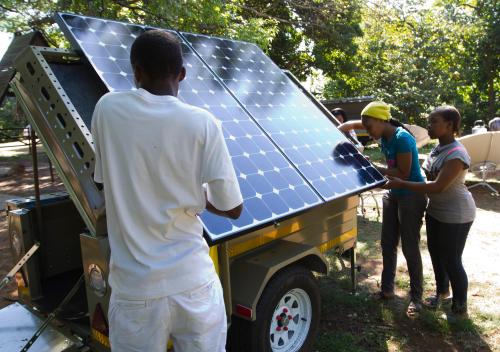1. What was the most interesting thing you heard today?
The need to get liquidity into the system immediately after a disaster.
The global community is organized to respond to disasters with life saving interventions. We have stand-by arrangements to rush in food, water, tents, blankets, medicine. But we have no stand-by arrangements to restore economic activity – to rebuild homes and businesses, restock stores, purchase fuel and other necessities of business and daily life. We need a mechanism for the immediate infusion of liquidity to business and individuals. Large financial institutions have that liquidity but lack an on-the-ground presence and willingness to take risk. Small banks and other institutions are located in situ but without the necessary cash. We need to establish a stand-by guarantee mechanism that will get cash from the large to the small providers of small amounts of credit and cash that will restart local financial engines.
2. Diego Comin’s policy brief,
The Evolution of Technology Diffusion and the Great Divergence
, suggested the transformative potential of leap-frog technologies may be overblown. How do you feel about that after today’s discussion?
The difference between Diego’s paper and today’s discussion on leap-frog technology is that Diego focuses on the macro and historic trends and the discussion today focused on the micro and the here and now.
Diego argues that the ability of new technologies to enable developing countries to catch up with more advanced countries is overblown. He makes the case that while we are seeing a convergence in the dissemination of new technologies, which today are rapidly made available globally, use of technology depends on existing knowledge and prior technological experience so poorer countries do not use the technology as effectively as more advanced countries.
The discussion, on the other hand, focused on specific technologies that are helping countries and people leapfrog over inadequate infrastructure. Cell phones are connecting people, transferring money, and delivering market information to rural farmers in the absence of landlines, formal banks, and market reports. Solar powered lights and power outlets are bringing electricity to those off the grid.
Both perspectives are right. Advanced countries may use technology more effectively, but new technologies are overcoming the lack of traditional infrastructure in other parts of the world to create new economic opportunities and improve lives.
3. What did you take away from the “Managing Risks in Conflict Settings” session?
It was such a rich discussion, but here are the issues that stood out for me:
- the private sector has to analyze and understand the root causes of conflict to avoid becoming part of it;
- a key ingredient of risk mitigation is hiring local talent, which is often absent but can be filled by diaspora. So a key strategy is getting the diaspora to return home;
- there was an apparent but not real dichotomy between the business representatives who were saying stay with small/medium projects and avoid government, and policy makers who said getting good governance was essential to moving beyond fragility and conflict;
- resistance to transparency is due less to reluctance on the part of companies, and more a consequence of governments who do not want companies to publish information on their payments to government.
4. Day Two covered three diverse, topics on “Managing Risks in Conflict Settings,” “Leap-Frogging Technologies,” and “Delivering Government Partnerships.” Did today’s sessions leave you with an impression of how development may change over the next few years?
An urgent challenge that people are beginning to deal with is the “software” of development. We are good at a lot of the technical fixes – medicines, bed nets, mobile money, small solar lights, etc. What is missing is the softer, knowledge side. But that is changing. One example is the growing realization that dealing with conflict and fragility is fundamentally a political issue. The New Deal for Fragile States recognizes that and puts fragile states in the lead to deal with the internal societal and political conflicts, with donors playing a supportive role. Another example is that the development community recognizes that successful interventions require multiple capabilities that are spread across government, business, and civil society. The missing ingredient is knowing how to join these diverse organizations into a common effort, and it is this systems integration that various organizations are now experimenting with solving. A third example is efforts to innovate the delivery of the technical solutions, getting that delivery into rural, isolated communities, and the internet and cashless financial device may offer some solutions.
The Brookings Institution is committed to quality, independence, and impact.
We are supported by a diverse array of funders. In line with our values and policies, each Brookings publication represents the sole views of its author(s).






Commentary
The 2014 Brookings Blum Roundtable: Reflections on Day Two
August 11, 2014